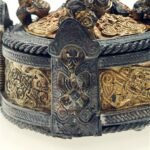The classic amulet of pre-Christian Scandinavia is almost certainly the Thor’s hammer—the Mjölnir pendant. Many artefacts of this type have been found throughout Viking Age Scandinavia, generally disappearing shortly after the conversion of Norse lands to Christianity. Meanwhile, however, in eastern Europe—where, in the 800s, Norse settlers had established a new culture that would come to be known as the Rus’—another sort of amulet had become fashionable.
The crescent pendant was a curious type of artefact. While a variety of different forms existed, in most took the form of a downturned half-moon, with a variety of designs on the body between the two horns. These pendants are frequent finds from the earliest days of the Rus’, and they attest to one of the Vikings’ perhaps less well-known qualities: their efficient cultural versatility. When Norse travellers settled abroad in the Viking Age, they were often quick to adopt local customs and blend them with their own, birthing new, hybrid cultures in the process. This might involve taking on aspects of local language, religion, dress, and putting a Norse spin on them; or else remodelling Norse traditions under the influence of their new neighbours. This took place clearly in Ireland and Normandy, and it was also important in the Norse settlements of eastern Europe.
The crescent pendants are strong evidence for this. With a likely origin in the ancient Mediterranean world, by the end of the Roman Iron Age they had found their way in various forms to the edges of the Empire, particularly its eastern frontiers. But while they are nearly unknown from within Scandinavia (excepting limited finds from Birka), within the first few decades of the Rus’ settlement, they appear in large numbers in Norse graves and hoards in the region. It is possible, indeed, that they were introduced to the early Norse travellers by the Eastern Romans themselves—that is, the Byzantines—as items of payment or trade, and the Rus’ seem to have taken a great liking to them.
The earliest crescent amulets from Rus’ sites are delicate items of silver filigree, likely meant for important occasions, but these were later superseded by cast and stamped bronze amulets that might have seen more regular use. Interestingly, amulets worn into the grave tended to be significantly smaller than those placed into hoards, and the larger artefacts sometimes show signs of being cut up or broken. This teases a further parallel in Norse custom, where jewellery such as arm-rings or brooches also functioned as a form of portable wealth, able to be chopped into pieces of silver (so-called “hacksilver”) to be used as currency. In this sense, it would make more sense for the smaller, more portable amulets to be used as personal adornments, and the larger versions to be kept aside for cash.

Unlike the Mjölnir pendants, the crescent pendants saw continued use for centuries after the Rus’ conversion to Christianity. If the pendant had been introduced to the Rus’ by the Christian Byzantines, then this would make perfect sense—but it also shows how flexible the symbolism of this artefact must have been, as the Rus’ themselves were not yet Christianised by the time they adopted it. While the crescent pendants never gained much popularity in the wider Viking world beyond the realm of the Rus’, this makes them a perfect illustration of the old Norse talent for adaptability—as well, perhaps, as the Vikings’ enduring love of a good fashion.
FURTHER READING:
Duczko, W. 1985. The filigree and granulation work of the Viking period: an analysis of the material from Björkö. Birka: Untersuchungen und Studien, 5. Almqvist & Wiksell. Stockholm.
Khamayko, N. 2012. Crescent pendants (lunnitsa) in 11th-13th century Rus’: Pagan amulet or Christian ornament? Rome, Constantinople and Newly-Converted Europe: Archaeological and Historical Evidence. Instytut Archeologii I Etnologii Polskiej Akademii Nauk. Warszawa.
Cover photo: Maria Orlova, from Pexels
About the author

Christopher Nichols
Archaeologist with a Bachelor of Arts from Simon Fraser University (Vancouver, Canada) and a Master of Arts from Uppsala University (Uppsala, Sweden). My specialisation lies in bioarchaeology broadly, with a primary focus on mammalian zooarchaeology, and a special interest in the Late Iron Age of Scandinavia (though you can occasionally catch me sniffing around Egypt as well).
In my Master research I conducted an osteological analysis of domestic dog remains from Valsgärde cemetery, Sweden. The aims were to identify the number of dogs buried at the site, reconstruct the appearance of the dogs, and identify any patterns and changes between the Vendel Period and Viking Age.
I’ve always been fascinated by the relationship between humans and animals, domestic and wild, in societies throughout the world. Through archaeology, I hope to shed light on this crucial part of our shared heritage.


